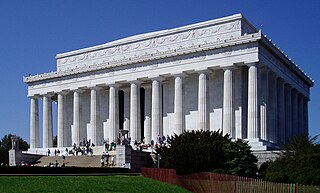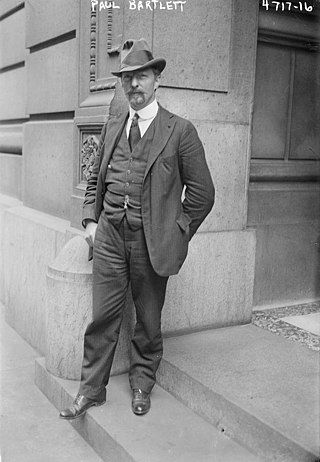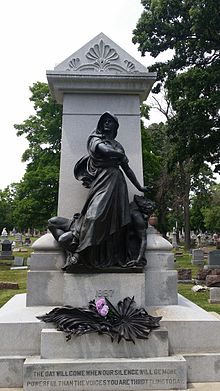
Daniel Chester French was an American sculptor of the late nineteenth and early twentieth centuries. He is best known for his 1874 sculpture The Minute Man in Concord, Massachusetts, and his 1920 monumental statue of Abraham Lincoln in the Lincoln Memorial in Washington, D.C.

Edward Clark Potter was an American sculptor best known for his equestrian and animal statues. His most famous works are the marble lions, nicknamed Patience and Fortitude, in front of the New York Public Library Main Branch

Henry Bacon was an American Beaux-Arts architect who oversaw the engineering and design of the Lincoln Memorial in Washington, D.C., built between 1915 and 1922, which was his final project before his 1924 death.

Adolph Alexander Weinman was a German-born American sculptor and architectural sculptor.

Karl Theodore Francis Bitter was an Austrian-born American sculptor best known for his architectural sculpture, memorials and residential work.

Charles Allan Grafly, Jr. was an American sculptor, and teacher. Instructor of Sculpture at the Pennsylvania Academy of the Fine Arts for 37 years, his students included Paul Manship, Albin Polasek, and Walker Hancock.

Cyrus Edwin Dallin was an American sculptor best known for his depictions of Native Americans. He created more than 260 works, including the Equestrian Statue of Paul Revere in Boston; the Angel Moroni atop Salt Lake Temple in Salt Lake City; and Appeal to the Great Spirit (1908), at the Museum of Fine Arts, Boston. He was also an accomplished painter and an Olympic archer.

Bela Lyon Pratt was an American sculptor from Connecticut.

Paul Wayland Bartlett was an American sculptor working in the Beaux-Arts tradition of heroic realism.

The Thomas Jefferson Building, also known as the Main Library, is the oldest of the Library of Congress buildings in Washington, D.C. Built between 1890 and 1897, it was initially known as the Library of Congress Building. In 1980, the building was named in honor of Thomas Jefferson, a Founding Father, the principal author of the Declaration of Independence, and the third U.S. president. In 1815, Jefferson's donation of his own book collection formed a core foundation for the library's collection.

Harold Van Buren Magonigle (1867–1935) was an American architect, artist, and author best known for his memorials. He achieved his greatest success as a designer of monuments, but his artistic practices included sculpture, painting, writing, and graphic design.

Roland Hinton Perry was an American sculptor and painter.

Philip H. Martiny was a French-American sculptor who worked in the Paris atelier of Eugene Dock, where he became foreman before emigrating to New York in 1878—to avoid conscription in the French army, he later claimed. In the United States he found work with Augustus Saint-Gaudens, with whom he remained five years; a fellow worker in Saint-Gaudens' shop was Frederick MacMonnies. A group photograph taken in Saint-Gaudens's studio about 1883, conserved in the Archives of American Art, shows Kenyon Cox, Richard Watson Gilder, Martiny, Francis Davis Millet, Saint-Gaudens, Julian Alden Weir and Stanford White.
Roman Bronze Works, now operated as Roman Bronze Studios, is a bronze foundry in New York City. Established in 1897 by Riccardo Bertelli, it was the first American foundry to specialize in the lost-wax casting method, and was the country's pre-eminent art foundry during the American Renaissance.

George Julian Zolnay was a Romanian, Hungarian, and American sculptor called the "sculptor of the Confederacy".

The Louisiana Purchase Exposition gold dollar is a commemorative coin issue dated 1903. Struck in two varieties, the coins were designed by United States Bureau of the Mint Chief Engraver Charles E. Barber. The pieces were issued to commemorate the Louisiana Purchase Exposition held in 1904 in St. Louis; one variety depicted former president Thomas Jefferson, and the other, the recently assassinated president William McKinley. Although not the first American commemorative coins, they were the first in gold.

Thomas Jefferson is a 1911 bronze statue of a seated Thomas Jefferson created by Karl Bitter for the Cuyahoga County Courthouse in Cleveland, Ohio, United States.

Bruno Louis Zimm was an American sculptor. He created a variety of works: fountains, memorials, freestanding sculptures, and architectural sculptures.

Stevens T. Mason, also known as the Stevens T. Mason Monument, is a monumental statue in Detroit, Michigan, United States. The monument was designed by sculptor Albert Weinert and architect H. Van Buren Magonigle in honor of Stevens T. Mason, who had served as the first governor of Michigan in the mid-1800s and is notable for being the youngest person to ever serve as the governor of a U.S. state. Mason's remains are interred underneath the monument, which is located in Capitol Park, the site of the former state capitol building. The monument was dedicated on Memorial Day 1908.


















